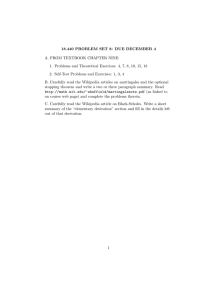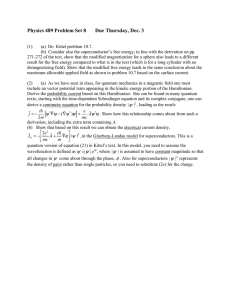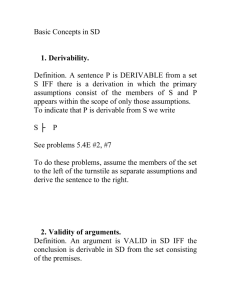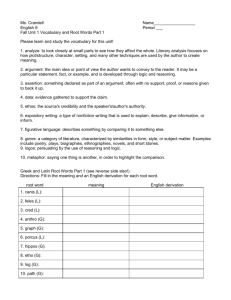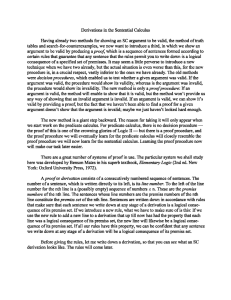Question 1
advertisement
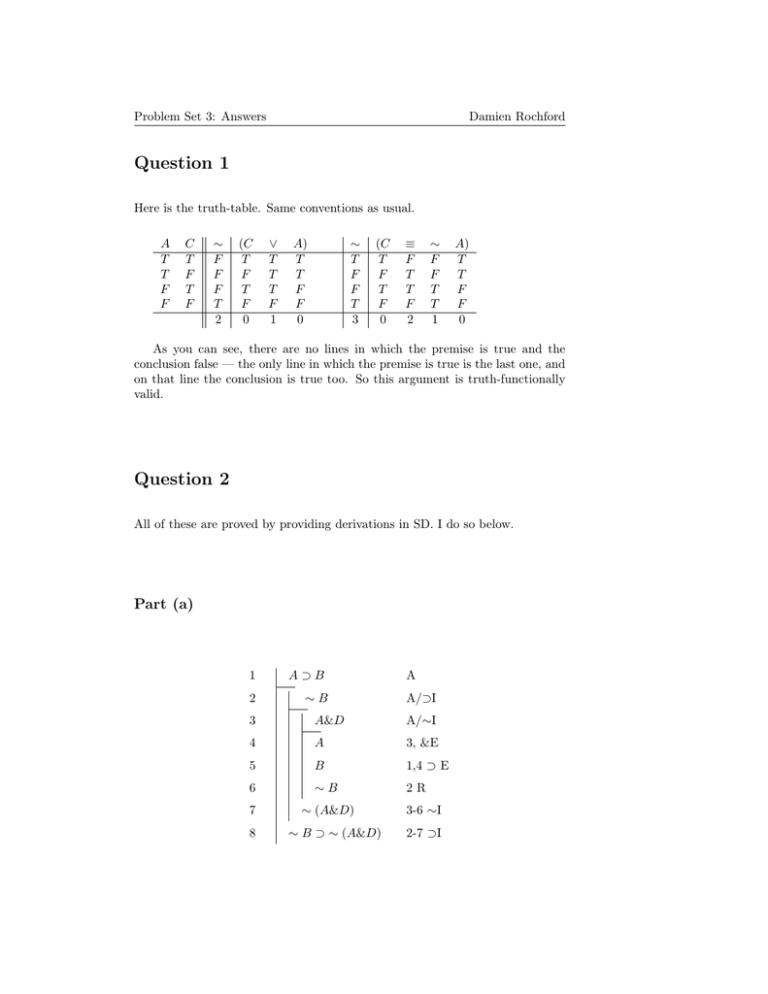
Problem Set 3: Answers
Damien Rochford
Question 1
Here is the truth-table. Same conventions as usual.
A
T
T
F
F
C
T
F
T
F
∼
F
F
F
T
2
(C
T
F
T
F
0
∨
T
T
T
F
1
∼
T
F
F
T
3
A)
T
T
F
F
0
(C
T
F
T
F
0
≡
F
T
T
F
2
∼
F
F
T
T
1
A)
T
T
F
F
0
As you can see, there are no lines in which the premise is true and the
conclusion false — the only line in which the premise is true is the last one, and
on that line the conclusion is true too. So this argument is truth-functionally
valid.
Question 2
All of these are proved by providing derivations in SD. I do so below.
Part (a)
1
A⊃B
2
∼B
A
A/⊃I
3
A&D
A/∼I
4
A
3, &E
5
B
1,4 ⊃ E
6
∼B
2R
7
∼ (A&D)
8
∼ B ⊃ ∼ (A&D)
3-6 ∼I
2-7 ⊃I
Part (b)
1
2
(A ⊃ B) ⊃ ∼ B
B
A
A/∼I
3
A
A/⊃I
4
B
2R
5
A⊃B
3-4, ⊃I
6
∼B
1,5 ⊃E
7
B
2R
8
∼B
2-8 ∼I
1
F ⊃ (G ∨ H)
A
2
∼ (∼ F ∨ H)
A
3
∼G
A
4
H
A/∼I
5
∼F ∨H
4 ∨I
6
∼ (∼ F ∨ H)
2R
Part (c)
7
∼H
4-6 ∼I
Question 3 (5.3E 12(b))
Let ‘A’ = ‘The recipe calls for flavouring’; ‘B’ = ‘The recipe calls for eggs’; ‘C’
= ‘The recipe is a recipe for tapioca.’
The relevant set of sentences is {‘(∼ A ∨ ∼ B) ⊃ ∼ C’, ‘B ⊃ (C&∼ A)’, ‘B’}.
The below derivation shows that this set is inconsistent in SD.
2
1
(∼ A ∨ ∼ B) ⊃ ∼ C
A
2
B ⊃ (C& ∼ A)
A
3
B
A
4
C&∼ A
2,3 ⊃E
5
∼A
4 &E
6
∼A∨∼B
5 ∨I
7
∼C
1,6 ⊃E
8
C
4 &E
Question 4 (5.3E 13(a))
This derivation rule allows one to derive something false from something true.
To see this: let P = A, Q = B, and consider the truth-value assignment that
assigns false to A and true to B. Under that assignment, ‘A ∨ B’ is true, but
‘B’ is false.
That’s bad — the only derivation rules we want are ones that guarantee that
the sentence you derive is true, given that the sentences you started with are
true.
Question 5 (5.3E 13(e))
Because, in SD, you can derive any conclusion from the negation of theorem.
Why is that? Suppose we have a derivation in SD with the negation of some
theorem P as an assumption on line i. As P is a theorem, we can derive it in
this derivation; say we do so on line j. Then, starting at line k > max(i, j), we
can construct a sub-derivation of the following form:
k
∼Q
A/∼E
k+1
P
jR
k+2
∼P
iR
k+3
k–k + 1 ∼E
Q
One can do this for any value of Q. So, one can derive any sentence from
the negation of a theorem, in SD.
Question 6
I like this one.
3
1
2
∼ ((A ⊃ B) ∨ (B ⊃ A))
A
A/∼E
A/∼I
3
B
A/⊃I
4
A
2R
5
B⊃A
3-4 ⊃I
6
(A ⊃ B) ∨ (B ⊃ A)
5 ∨I
7
∼ ((A ⊃ B) ∨ (B ⊃ A))
1R
8
∼A
9
A
2-7 ∼I
A/⊃I
10
∼B
A/∼E
11
A
9R
12
∼A
8R
10-12 ∼E
13
B
14
A⊃B
9-13 ⊃I
15
(A ⊃ B) ∨ (B ⊃ A)
14 ∨I
16
∼ ((A ⊃ B) ∨ (B ⊃ A))
1R
17
(A ⊃ B) ∨ (B ⊃ A)
1-16 ∼E
Question 7
Consider an SD derivation and sentences P, Q of SL such that �P ∨ Q� appears
on line i of the derivation, to the right of m scope-lines, and �∼ P� appears
on line j of the derivation, to the right of n scope lines. Starting at row k >
max(i, j), and to the right of max(m, n) − 1 scope lines, one can construct a
sub-derivation of the following form:
4
k
P
A/∨E
k+1
∼Q
A∼E
k+2
P
kR
k+3
∼P
jR
k+4
Q
k + 1-k + 3 ∼E
k+5
Q
A/∨E
k+6
Q
k+5 R
k+7
Q
i, k – k + 4, k + 5 – k + 6 ∨E
Using this construction, one can always derive Q, from �P ∨ Q� and �∼ P�,
in SD. So anything we can derive in SD� we can derive in SD.
5
MIT OpenCourseWare
http://ocw.mit.edu
24.241 Logic I
Fall 2009 For information about citing these materials or our Terms of Use, visit: http://ocw.mit.edu/terms.

